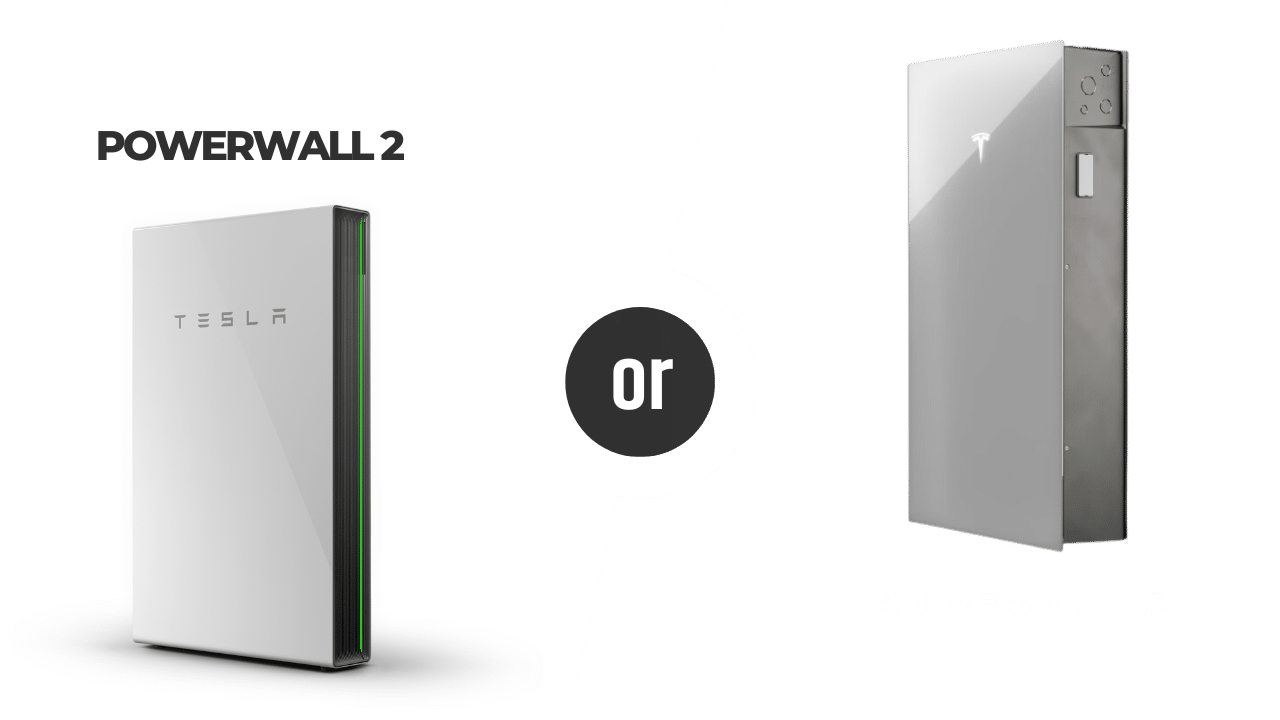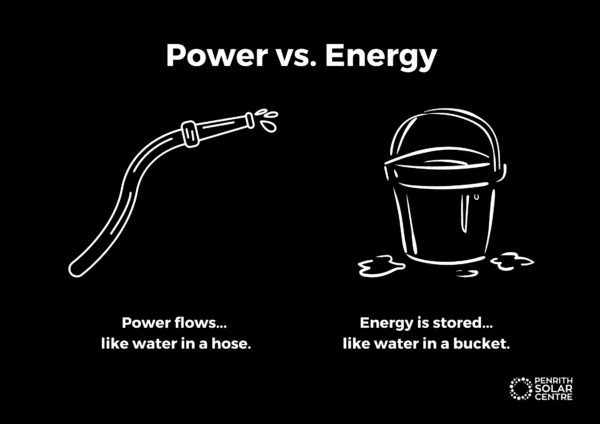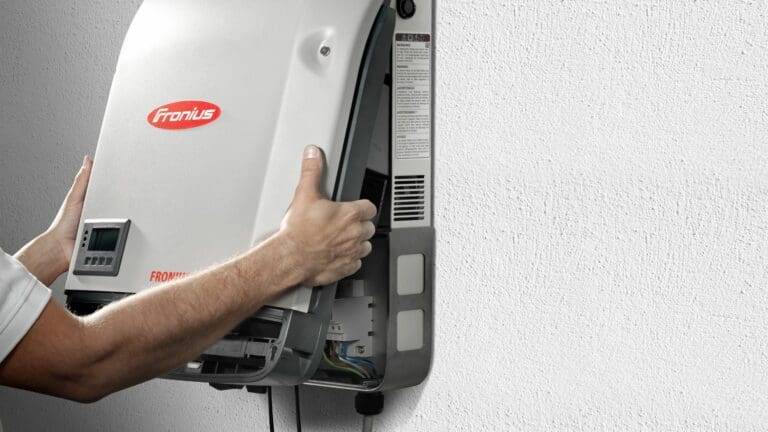
This post has been updated since its publication date. It was updated on 28 August 2024.
Whenever Tesla releases a new product, it’s an event for solar industry folks and customers alike. With the launch of the Powerwall 3, we’re getting a lot of questions about how it compares to the previous models.
The Powerwall 2 has been around since 2016 and has gone through a variety of updates since then. It’s an incredible battery that will soon be phased out of the market. Currently, the Powerwall 2 is being manufactured to order.
This article uses a comparison framework to best demonstrate how the new Powerwall 3’s achievements and shortcomings differ from those of its predecessor.
At Penrith Solar Centre, we’ve sold the Powerwall 2 since it arrived on the market in Australia, so we know a thing or two about them. We want you to be an informed shopper who can get a view of the big picture as well as the details. The Powerwall 3 has been available in North America for a year now, and we have all the details for it now that it’s launched in Australia.
In this article, we’ll cover:
- What is the Powerwall 3?
- How Does the Powerwall 3 Compare to the Powerwall 2?
- What Is the Difference Between Powerwall 2 and Powerwall 3?
- How Much Does Powerwall 3 Cost?
- Pros and Cons of the Powerwall 3
- Who is Powerwall 3 a Good Fit For?
- Who Is Powerwall 3 a Bad Fit For?
By the end of this article, you’ll know more about the Powerwall 3 and whether or not it’s a good fit for your energy lifestyle.

What is the Powerwall 3?
In 2012, Tesla developed batteries for their electric cars and started experimenting with larger energy storage solutions. In 2015, the first Powerwall was released, named the Powerwall 1. It was soon replaced by the Powerwall 2 in 2016, which has been updated over the past six years as the company refined the product.
Powerwall 3 is a solar battery that stores energy from solar panels or the grid. If your solar panels produce more energy than you need, Powerwall 3 can store it for later use. This stored energy can be used when your panels aren’t producing, like at night or during a power outage.
One of the most notable features of the Powerwall 3 is its built-in hybrid inverter, which converts direct current (DC) power from the solar panels or battery into alternating current (AC) power for your home to use.
The specifics of how it converts that power depend on whether your solar system has AC architecture (like a microinverter system) or DC architecture (a string inverter system).
The integration of this hybrid inverter directly into the battery unit eliminates the need for a separate central inverter, reducing costs and freeing up wall space.
However, it’s important to note that this integrated hybrid inverter has a potential downside: a single point of failure. If the inverter malfunctions, it could leave you without access to your solar system (and all the money it’s saving you!) until it is repaired or replaced. It’s a major drawback for central inverter systems.
Monitoring Software
The Powerwall 3 is programmable through the Tesla App. It can observe and direct your energy usage based on history, local weather forecasts, and even electricity prices. It uses this information to optimise your system’s performance.
The Time-Based Control mode, for instance, allows the Powerwall 3 to use stored energy when electricity prices are high, helping you save money on your utility bills. In some areas, you can even send energy back to the grid when demand is high, earning payments from your energy retailer in the form of a feed-in tariff or a variable feed-in rate.
Blackout protection during outages is crucial. The Storm Watch feature is constantly monitoring the weather so it can automatically fully charge to prepare for an outage.
Another impressive feature of the Tesla App is its ability to program your Tesla electric vehicle (EV) to charge directly from your solar energy. You can set it to charge your EV during the day or night, even during a power outage, ensuring that you always have a reliable source of power for your vehicle.
If you’re interested in learning a bit more about how to set up and use the Tesla App, you might want to check out the following article titled, How to Set Up and Use the Tesla Powerwall App.
How Does the Powerwall 3 Compare to the Powerwall 2?

Much like the famed Rumble in the Jungle where a young Muhammad Ali introduced his signature rope-a-dope tactic to knock out George Foreman in the eighth round, the Powerwall 2 and Powerwall 3 go head-to-head in the following chart:

Keep reading as we break down these categories!
What Is the Difference Between Powerwall 2 and Powerwall 3?
Energy Capacity
The energy capacity of both the Powerwall 2 and Powerwall 3 is 13.5kWh. This capacity refers to the amount of energy the battery can store and is measured in kilowatt-hours (kWh). For context, 13.5kWh is enough to power the average home for several hours during an outage or during periods of low solar production.

Power Capacity
The Powerwall 2 has a continuous power rating of 5kW, with a peak power rating of 7kW for short bursts, like when starting large appliances. The Powerwall 3, on the other hand, boasts a continuous power rating of 11.04kW. This significant increase in power capacity means the Powerwall 3 can handle more demanding energy needs.
However, it’s crucial to understand that local grid regulations and restrictions will require the inverter to be limited to 10kW, depending on where you live. Your installer will be able to program this setting for you.

Operating Temperature
Both the Powerwall 2 and Powerwall 3 can operate in temperatures ranging from -20°C to 50°C. However, the Powerwall 2 is liquid-cooled, which helps it maintain an optimal operating temperature more efficiently.
The Powerwall 3, on the other hand, is air-cooled, which means it relies on fans to regulate its temperature. While this design choice has allowed Tesla to reduce costs, it does mean that the Powerwall 3 will generate some noise when the fans are running at full speed.
Weight and Size
The Powerwall 3 is heavier than the Powerwall 2, weighing in at 130 kg compared to the 114 kg of the Powerwall 2.
In terms of size, the Powerwall 3 measures 1099 mm x 609 mm x 193 mm, compared to the Powerwall 2’s dimensions of 1150 mm x 753 mm x 147 mm. While the Powerwall 3 is deeper/thicker, it’s also narrower and shorter, which could make it easier to fit into tight spaces.
Because the Powerwall 3 is heavier, it’s important to note that Tesla has taken installers into consideration. The mounting bracket was redesigned and with the leveling feet, so you’ll always get a perfect finish to your installation.
Safer Chemistry
The Powerwall 3 uses a lithium iron phosphate (LFP) battery chemistry, which is cobalt-free. This is an upgrade from the lithium-ion NMC (Nickel-Manganese-Cobalt) chemistry used in the Powerwall 2.
LFP batteries are generally considered safer and more environmentally friendly because they are less prone to overheating and do not contain cobalt. Cobalt is a controversial and expensive material to mine; often associated with unethical mining practices.
Installation Considerations
Both versions of the Powerwall can be wall-mounted or floor-mounted, and the choice between the two will depend on the structure of your home and available space. Wall mounting requires a sturdy wall that can support the weight of the unit, while floor mounting might be a better option for some situations.
If you’re interested in learning about types of solar batteries, you might want to check out the following article titled, AC-coupled Battery vs. DC-coupled Solar Batteries.
How Much Does Powerwall 3 Cost?
Let’s get the big question out of the way: Cost. How much is it?
Powerwall 3 is $11,900 + Gateway $1,700
Powerwall 2 was $10,400 + Gateway $1,700
It’s a step up in price from its predecessor. The Powerwall 3’s higher cost reflects its increased capabilities, including the built-in inverter and higher power output. However, it’s important to consider whether these upgrades are worth the extra expense for your specific needs.
The price does not include installation.
Pros and Cons of the Powerwall 3
Pros:
- Integrated Solar Inverter: The Powerwall 3 comes with an 11.04 kW built-in hybrid inverter, reducing the need for a separate central inverter. This means it’s one less component to invest in if you want a system with DC architecture.
- Working with Solar Panels: The Powerwall 3 supports up to 20kW of solar panels, allowing for significant energy production and storage. It’s a system with DC architecture, so the solar directly feeds the battery allowing for greater charging efficiency of 97.5%.
- Power Output: With a continuous power output of 11.04kW programmed to 10kW in NSW, the Powerwall 3 meets the demands of larger households and energy-intensive appliances.
- Scalable Storage: Currently, the Powerwall 3 can stack up to four units together for 54kWh total. Tesla has announced that in the first quarter of 2025, they’ll release battery units without a hybrid inverter inside. These “dumb” battery units can be stacked up to 16 units or 216kWh. This battery’s expandability is perfect for those with growing energy needs or who plan to add an electric vehicle.
- Charge On Solar: The ability to bypass the grid and directly charge your electric vehicle from your solar system is a standout feature. This not only reduces your reliance on the grid but also takes advantage of your solar energy, even during outages.
- Safety: The Powerwall 3’s lithium iron phosphate (LFP) chemistry is safer than the lithium-ion NMC chemistry used in the Powerwall 2. This reduces the risk of overheating, providing peace of mind for homeowners.
Cons:
- DC Architecture: The Powerwall 3 can be installed with AC or DC architecture in a solar system; however, it was designed to replace the central inverter in a system with DC architecture. If you choose to install the Powerwall 3 as your inverter/battery combo and connect it to the solar on the roof through DC-coupling, you’ll have all the risks and potential problems of similar systems with a central inverter.
- Backwards Compatibility Issues: One of the most significant drawbacks of the Powerwall 3 is its lack of backward compatibility. You cannot connect a Powerwall 2 to a Powerwall 3, which is probably frustrating for existing Powerwall 2 owners looking to expand their system.
- Higher Cost: The Powerwall 3 is more expensive than the Powerwall 2. The price increase may not be justified for all customers, particularly those who don’t need the higher power output or integrated inverter.
- Noise from Cooling Fans: The Powerwall 3 relies on air cooling, and the fans can generate noise when the unit gets hot. This could be a drawback depending on where you want your battery installed.
If you’d like to learn a bit more about what solar batteries are on the market, you might want to check out the following article titled, 6 Best Solar Batteries on the Market.
Click here for solar solutions.
Who Is Powerwall 3 a Good Fit For?
Single-Phase Homes
The Powerwall 3 is designed specifically for single-phase homes. If you’re planning to install it on a three-phase site, be aware that it can be tricky and expensive due to technical complications. A good solar installer can walk you through that.
New Solar + Battery Installations
Pairing the Powerwall 3 with solar panels is an economical choice, thanks to its built-in hybrid inverter. Installing both the solar panels and the battery together can save you money.
Tesla Enthusiasts
Tesla makes top-notch products, and those who already own and love Tesla items will find that the Powerwall 3 fits perfectly into their electric lifestyle. Whether you have a Tesla car or plan to get one, this battery will integrate seamlessly with the rest of Tesla’s products.
Homes in Blackout-Prone Areas
If your area experiences frequent blackouts, the Powerwall 3 is a solid option. It can provide up to 10kW of continuous power in NSW homes, which is enough to keep your lights and some appliances running during outages.
If you’re interested in learning a bit more about installing a single-phase battery like the Powerwall 3 on a three-phase site, you might want to check out the following article titled, Can I Install a Single-Phase Battery on a Three-Phase Home?
Who Is Powerwall 3 a Bad Fit For?
Retrofitting Existing Solar Systems
If you already have a solar system with microinverters and are looking to add a battery, the Powerwall 3 is an expensive choice. You may want to explore other, more cost-effective options. Personally, we love the Enphase IQ Batteries.
Three-Phase Homes
As mentioned earlier, Powerwall 3 isn’t the best fit for three-phase homes if you’re installing the battery as a string system. These homes require balanced phases, which is challenging with this battery. If you’re still a bit unclear about single-phase and three-phase requirements, you might want to try the following article titled, Single-Phase vs. Three-Phase: How Are They Different?
Decentralised Solar Systems
If you prefer a solar system without a single point of failure, the Powerwall 3 won’t suit your needs. It has only one inverter, so if that inverter fails, your entire system will go down. It doesn’t matter if the battery is AC or DC-coupled, the single inverter is still a central point of potential failure.
However, when installed with an AC system like Enphase, the solar will continue working while the battery is being repaired or replaced. This is not the case in a DC-coupled scenario when the Powerwall 3’s hybrid inverter is running the battery as a string system.
Safety-Conscious Homeowners
High-voltage DC systems, like the one used by the Powerwall 3, carry inherent risks. While the battery is safe when installed properly, not every installer is perfect. Ensure you choose a skilled installation company to avoid potential risks.
Noise-Sensitive Users
The cooling fans in the Powerwall 3 can be noisy. If you’re sensitive to sound or want the battery in a quiet part of your garage, this might be an issue.
Owners of Powerwall 2
The Powerwall 3 doesn’t work with the Powerwall 2. If you already own a Powerwall 2 and want more storage, you’ll need to get another Powerwall 2 soon, as it’s being phased out in favour of the Powerwall 3.
If you’re interested in hearing what our customers are saying about our apprentices and installers, you might want to check out the following article titled, “I’ve never had a more positive experience with tradespeople.” – How Tabitha Saved with Penrith Solar Centre.
Conclusion: Don’t Spook a Battery in the Wild. It Will Charge.
Now you know more about the new Tesla Powerwall 3 and how it compares to its predecessor, the Powerwall 2. While we love the efficiencies of the battery and how they contribute to your bottom line, the lack of compatibility is disappointing and has left us scratching our heads.
At Penrith Solar Centre, we keep our eyes on all new developments in the solar industry. There’s a bit to celebrate with the Powerwall 3, but there’s also a bit to be cautious about with this new piece of technology.

If you’re interested in learning a bit more about the upcoming solar battery rebate, you might want to check out the following article titled, Everything You Need to Know About the Home Battery Rebate for NSW.










